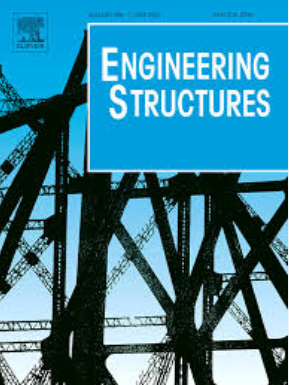发展具有物理信息的神经网络,用于移动荷载梁的虚拟传感
IF 5.6
1区 工程技术
Q1 ENGINEERING, CIVIL
引用次数: 0
摘要
物理信息神经网络(pinn)在结构健康监测和相关应用中表现出前景,因为它们有可能通过符合控制微分方程以及位移和力边界条件等物理约束来表示物理系统和过程。本文解决了开发可预测桥梁结构在移动集中荷载(如车辆的轴载)下响应的pin n的挑战。它还展示了pin在虚拟传感方面的潜力,即在传感器可能不可用的位置预测响应参数。所提出的pin n假设负载以恒定速度移动,并使用负载进入桥梁的时间来评估其相对于时间的位置。该研究最初提出了一个仅以响应位置为输入的一维PINN,并通过将车辆通过时间和负载大小作为附加输入逐渐将维度(输入数)增加到3。本研究对PINN模型的参数进行了全面的敏感性分析,以了解其对模型训练和性能的影响。最后,研究了具有监测数据的实际桥梁梁的最终PINN模型的性能。证明了PINN在没有物理配备传感器的位置预测应变、挠度和内力的能力,并且观察到应变预测与现场监测的实际测量结果密切相关。本文章由计算机程序翻译,如有差异,请以英文原文为准。
Developing physics-informed neural networks for virtual sensing in beams with moving loads
Physics-informed neural networks (PINNs) show promise for structural health monitoring and related applications since they have the potential to represent physical systems and processes by conforming to governing differential equations as well as physical constraints such as displacement and force boundary conditions. This paper addresses the challenge of developing PINNs that can predict the response of bridge structures under a moving concentrated load such as from the axle load for a vehicle. It also demonstrates the potential of PINNs for virtual sensing, i.e., predicting response parameters at locations where sensors may not be available. The proposed PINNs assume that the load moves at constant speed and uses the time at which the load enters the bridge to evaluate its position with respect to time. The study initially proposes a one-dimensional PINN that takes only response location as input and gradually increases dimensionality (number of inputs) to three by including the vehicle passage time and load magnitude as additional inputs. The study conducts a thorough sensitivity analysis of the PINN model’s parameters to understand their influence on model training and performance. The performance of the final PINN model is investigated for a real-world bridge girder for which monitoring data is available. The capacity of the PINN to predict strains, deflections and internal forces in locations that are not physically equipped with sensors is demonstrated, and strain predictions are observed to closely follow actual measurements from field monitoring.
求助全文
通过发布文献求助,成功后即可免费获取论文全文。
去求助
来源期刊

Engineering Structures
工程技术-工程:土木
CiteScore
10.20
自引率
14.50%
发文量
1385
审稿时长
67 days
期刊介绍:
Engineering Structures provides a forum for a broad blend of scientific and technical papers to reflect the evolving needs of the structural engineering and structural mechanics communities. Particularly welcome are contributions dealing with applications of structural engineering and mechanics principles in all areas of technology. The journal aspires to a broad and integrated coverage of the effects of dynamic loadings and of the modelling techniques whereby the structural response to these loadings may be computed.
The scope of Engineering Structures encompasses, but is not restricted to, the following areas: infrastructure engineering; earthquake engineering; structure-fluid-soil interaction; wind engineering; fire engineering; blast engineering; structural reliability/stability; life assessment/integrity; structural health monitoring; multi-hazard engineering; structural dynamics; optimization; expert systems; experimental modelling; performance-based design; multiscale analysis; value engineering.
Topics of interest include: tall buildings; innovative structures; environmentally responsive structures; bridges; stadiums; commercial and public buildings; transmission towers; television and telecommunication masts; foldable structures; cooling towers; plates and shells; suspension structures; protective structures; smart structures; nuclear reactors; dams; pressure vessels; pipelines; tunnels.
Engineering Structures also publishes review articles, short communications and discussions, book reviews, and a diary on international events related to any aspect of structural engineering.
 求助内容:
求助内容: 应助结果提醒方式:
应助结果提醒方式:


